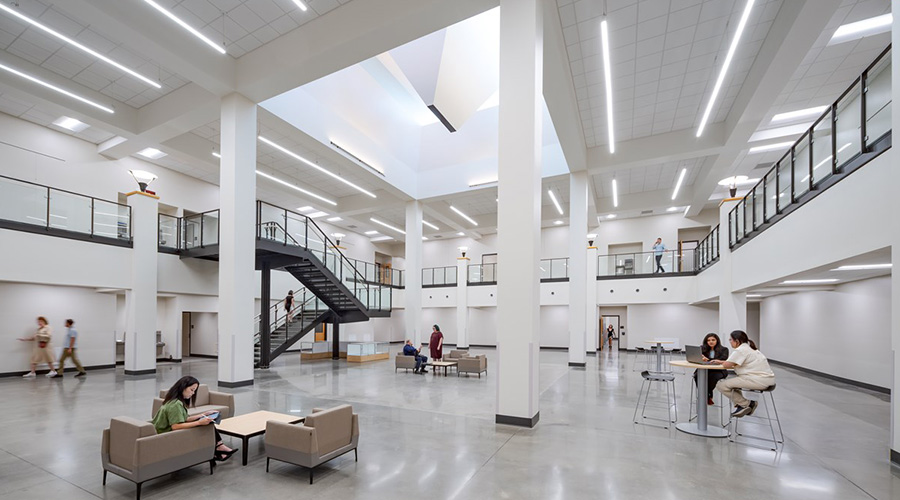Small Steps, Big Savings
Managers tap into ENERGY STAR resources to pinpoint often-overlooked savings that benefit the bottom line
Maintenance and engineering managers “walk by $1,000 worth of opportunities everyday,” says Delbert Reed, director of engineering and maintenance and safety officer at Shriners Hospital in Houston. The key to energy conservation is finding and taking advantage of these little things.
“A lot of the things you can do to save energy aren’t rocket science,” says Reed, who oversees the maintenance and operations of the 40-bed, nine-story hospital. “You just have to look at your building with an open mind.” Reed estimates that by the end of 2006, the small steps his organization has taken to reduce energy use over the past 10 years will have saved about $1.2 million.
Reed and his organization are not alone. A growing number of managers are taking advantage of the U.S. Environmental Protection Agency’s ENERGY STAR program, which offers a host of resources to managers in institutional and commercial facilities looking to conserve energy, including its Portfolio Manager and Guidelines for Energy Management.
By using these tools, making relatively simple changes in operation, and taking advantage of low-cost technologies, managers can make tremendous improvements in their facilities’ energy efficiency.
Track Consumption
Implementing energy-tracking software is one of the first steps managers should take, says Dave Cone, assistant operations and maintenance supervisor at Gresham-Barlow School District in Gresham, Ore. The district contains 20 schools that range up to 290,000 square feet. In April 2006, it won the Energy Star Partner of the Year award.
Since the district began its energy-conservation efforts in 1998, it has cut its energy use by 46 percent and saved $5.5 million. During the 2005-’06 school year, the district cut more than $1 million in utility costs.
Cone’s efforts to minimize energy use began by talking with managers at other school districts that managed energy well.
“One of things that they said you absolutely have to do is track your energy usage,” he says. At the time, he didn’t fully understand the benefits of using software to track energy. Before implementing the software, his department didn’t track energy costs.
“The utility bills went to the accounting department, and they paid them,” he says. “No one paid attention if the bill was $2,000 this month and $4,000 next month. Once I got involved in energy management and used the software and produced the reports, I began to realize the value of tracking our energy usage.”
Simply having the data is not always enough to identify areas of energy waste. Reed now tracks his facilities’ energy data, such as its peak load demand, chilled-water consumption, and steam consumption.
“The problem I had was extrapolating that data into useful information,” Reed says. Specifically, he wanted to know how efficient his facilities were compared to similar buildings.
He imported his data into the ENERGY STAR Portfolio Manager software, which rates the energy performance of buildings on a scale up to 100 relative to similar buildings nationwide. The system accounts for annual weather variations, as well as building size, location, and operating characteristics. Managers can use the tool, which is available free from the EPA, to measure and track energy performance. Buildings that achieve 75 or higher on the rating system earn the ENERGY STAR label.
“I think in the past, people really didn’t pay attention to these opportunities,” says Jennifer Kearney, New York-Presbyterian Hospital’s energy programs manager. “ENERGY STAR really helps us set a goal for ourselves and try to achieve it.” Kearney maintains data on the hospital’s five facilities in the Portfolio Manager, and two of those facilities have earned ENERGY STAR labels.
Adjust Operations
Streamlining operations has led to the largest energy savings in Cone’s district. Simple practices, such as making sure lights, computers and ventilation systems are turned off in unoccupied areas, can contribute significantly.
Often, managers are skeptical that basic changes in behavior can save them money because they can’t easily see the savings.
“During a retrofit, managers might replace 40-watt lamps with 32-watt lamps, and they can do the math and see that they are saving 8 watts per lamp,” he says. But they can’t calculate the benefits of changing operations as easily. Managers who make changes in operations might see the biggest energy reductions in newer buildings, but new doesn’t automatically mean efficient.
“I would caution people to not assume a label, like a green label, equates to energy savings,” Cone says. Even new buildings with the latest generation of energy-saving systems and components can be big energy hogs because of inefficient operations.
For example, one of his district’s new schools had one of the highest energy-per-square-foot consumption in the district.
“It had occupancy sensors, timers for the outside lights, all sorts of bells and whistles designed to save energy,” he says. “Yet it was using more energy than any other school.”
This illustrates that technology alone cannot guarantee a high level of energy performance. In addition to making sure systems are running as designed, managers should analyze all power-consuming equipment, such as vending machines, that might offer opportunities for improvement.
“We installed vending misers for all the vending pop machines so they weren’t running when there wasn’t a demand on their system,” Cone says.
Staff training on energy efficiency also can pay dividends.
“We created a program in some of our hospitals to teach the operators efficient practices, such as which systems to run first and which systems to turn on and off as we approach peak loads,” says Joe Castellano, director of engineering for New York-Presbyterian Hospital’s Allen Pavilion. “The training has saved us a tremendous amount of energy.”
An organization-wide policy for temperature settings also can conserve energy. For example, the policy in Gresham-Barlow School District calls for heating buildings to 68 degrees and cooling them to 74 degrees.
“If a teacher during the heating season says they’re too cold, but we heated it to 68, then there is no pressure on the principle to bump it up to 70 or 71,” Cone says. “Now the principle can say, ‘I would like to do something for you, but we have to stick to the district’s standards.’ ”
Low-cost Solutions
Luckily, saving energy doesn’t require major investments.
“I haven’t gone out and spent a million dollars,” Reed says, who is hoping his hospital soon will achieve a perfect score of 100 in the ENERGY STAR rating system. “I’ll spend $120 and retrofit a conference room with occupancy sensors and see a return on investment in three to five months.”
In many cases, a solution is relatively simple, even though it might not be obvious. One major energy issue Reed faced was related to a steam table in the hospital’s laundry room.
“Our laundry room uses about 2.5 tons of steam an hour, and the air conditioner in that area delivers a maximum of about 2.5 tons of cooling an hour,” Reed says. “The steam table was eating up all of the cooling I could put in there, and it was always 80-81 degrees in that area. For about $85, I installed an electrical-actuated steam valve and put a mechanical timer on it. Now, when the people want to use the table they turn the mechanical timer on.” The steam table heats up in three minutes, and the timer automatically shuts it off in two hours.
“I messed with this problem for six years,” Reed says, and his staff continually tested all of the mechanical systems affecting that area. But the day after the installation, an employee in the laundry room said she was cold, and Reed was relieved.
“That meant that what we did worked,” Reed says, “Because before that, she always said the room was too hot.” The $85 solution turned in tremendous savings.
“I saved about $8,000 that year in steam costs,” he says, adding that for every $1,000 in steam costs, the district saves $2,000 in chilled-water costs. “And on top of all that, I had a satisfied customer.”
The three dryers in the laundry room also offered an energy-saving opportunity because their lint traps were not insulated.
“So if you put your hand against that area, I bet it was about 130-140 degrees,” Reed says. “I took some 1-inch air-conditioning duct board and laminated it to the face of the lint door. Now if you put your hand against it, it might be 80-85 degrees.”
Stopping the heat from entering the conditioned space reduces the amount of energy it takes to remove that excess heat.
Insulation can be one of a manager’s best tools in energy conservation.
“Our steam lines are all insulated, but the valves and steam traps were not, so I was dissipating a tremendous amount of heat,” Reed says. “We installed some large removable blankets that go around the OS&Y (outside, yolk and screw) valve, and now I’m able to keep about 85-90 percent of my heat inside the steam line, as opposed to letting it dissipate out into conditioned space.”
Reading the Label
Obviously, specifying new equipment is unavoidable, but when possible, managers should specify equipment with the Energy Star label, Kearney says.
“I highly recommend getting those products,” she says. “That is something very simple that you can do to save energy, and in a lot of cases, there is no difference in costs.”
Adds Cone, “I would highly recommend people using the ENERGY STAR model.” When he started his district’s energy-conservation program, he wasn’t aware of ENERGY STAR'S Guidelines for Energy Management, which enables managers to assess energy performance, set goals, create and implement a plan, evaluate progress and recognize achievements.
“We were busy re-creating the wheel, and we didn’t need to,” he says. “Everything we did was already in the guidelines.”
Related Topics:











